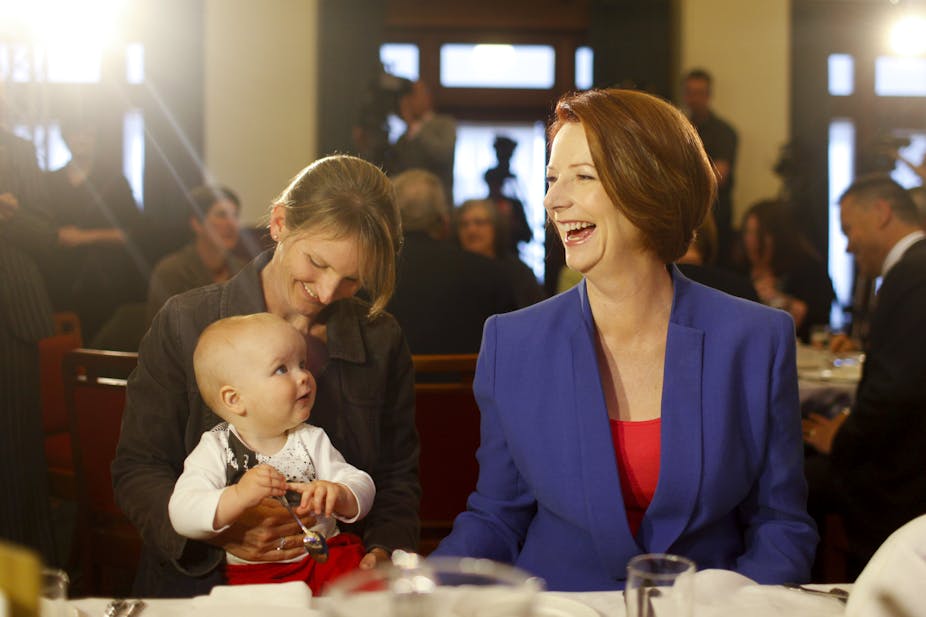A “gender dimension” now envelopes national politics unlike anything we have observed in the past. Julia Gillard’s popular but arguably unfair [accusation](http://www.abc.net.au/news/2012-10-10/international-reaction-to-gillard-speech/4305294](http://www.abc.net.au/news/2012-10-10/international-reaction-to-gillard-speech/4305294) that opposition leader Tony Abbott is a misogynist quickly became an international talking point last October.
The question is: does it unconsciously reflect something deeper about how Australian men and women view the two major parties and their current leadership?
In 2010 a gender gap emerged between men and women voters’ assessment of the major parties and their respective leaders. Interestingly, while Labor continues to lose voter support across the board, the gap remains - relatively speaking - intact.
Briefly, I will review a little of what we know about the so-called gender gap and how it may play a role in shoring up Labor’s vote.
The survey data employed derives from the Australian Election Study (AES) survey series and its comparable predecessor surveys and adds to Peter Brent’s insightful analysis in The Australian. AES is conducted out of the Australian National University and is a reputable poll: it is certainly far more comprehensive in its scope than the frequently discussed major polls such as Newspoll, Galaxy and Nielsen.
Of course, surveys alone cannot not render the “truth”. They merely act as a guide as to what might be going on in “voterland”. They are, in my view, a very a handy means for cross-checking against our own more anecdotal assessments and, importantly, for tracking change over longer time scales.
Recently we read that women stand ready to end the reign of Australia’s first female prime minister on September 14, with just one in three women - 36% - preparing to vote Labor as “good policy beats gender politics”. If the mood among many women voters who supported Gillard and Labor in 2010 is shaping for a rethink, then Labor is in deep trouble, for in recent times women have formed the majority of those who vote Labor.
For students of voting behaviour, the “gender gap” refers to the different proportions of men and women who support the major parties at each election. Historically speaking it evolved as way of simply highlighting that women voters tended to be more “conservative” than men. The focus was mainly on Labor’s “problem with women” due to the fact that Labor consistently drew much stronger support from men.
As Ian McAllister reports in his excellent book The Australian Voter, this has been an international historical phenomenon for left of centre parties, but over the last couple of decades the gap diminished steadily.
The chart below indicates a clear direction of change. Of course, women may still represent the majority of Labor voters in 2013 but this will likely be off a much diminished Labor total vote. What the chart points to, I believe, has something to do with changing social demographics: most notably women’s greater presence in the lower-paid ranks of the labour force and family break-up.

Note the spike upwards when Labor presented during the 1993 with an “aggressive” leader, namely prime minister Paul Keating. During his 1993 election night victory speech Keating singled out women voters for their support: “extra special note of thanks to the women of Australia who voted for us believing in the policies of the government”. The evidence suggests this was a mistaken belief but it does point out a lesson Tony Abbott would be wise to take on board.
In many respects, the “gender gap” among Coalition voters is the inverse to what we find with Labor. But the trend shift is more pronounced and occurred a decade earlier, when in the late 1990s the proportion of men voting for either the Liberal or National parties increases.

Finally, when analysing the data from Newspoll on the current state of play with the gender gap it is clear that women, like men, are increasingly dissatisfied with Gillard’s performance.
Here it is customary to consider the so-called “net satisfaction rating” by subtracting survey respondents who say they are “satisfied” from those saying they are “dissatisfied”. Averaged across three polls since mid-2012, Gillard rates a negative 16% among women compared to a negative 27% among men – quite a gap. With regard to Abbott, women register 29% negative, while men are not so jaundice at negative 22%. Overall, this is a poor result for both leaders but not unprecedented.
Looking back in time it may surprise to learn that while both Gillard and Abbott are unpopular by this measure, past contesting leaders such as Hawke and Peacock in 1990, Keating and Hewson in 1993 and Keating and Howard in 1996, did not always fare that much better. For example, Keating went into polling day 1993 with a negative 27% and managed to win the election.
There is no suggestion here that Gillard is about to repeat that performance. However, talk of a landslide win to Abbott in September needs to be tempered by the fact that among women voters, Gillard has the chance to shore up her party’s defences to a greater extent than is currently recognised by those predicting Labor losing up to 30 seats in the House of Representatives.

